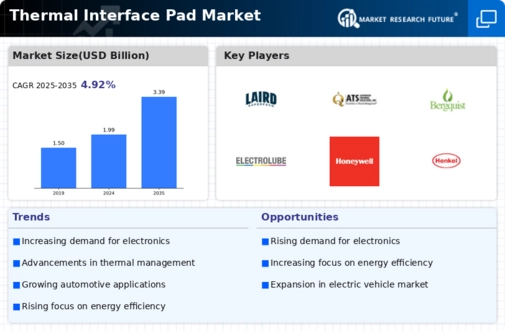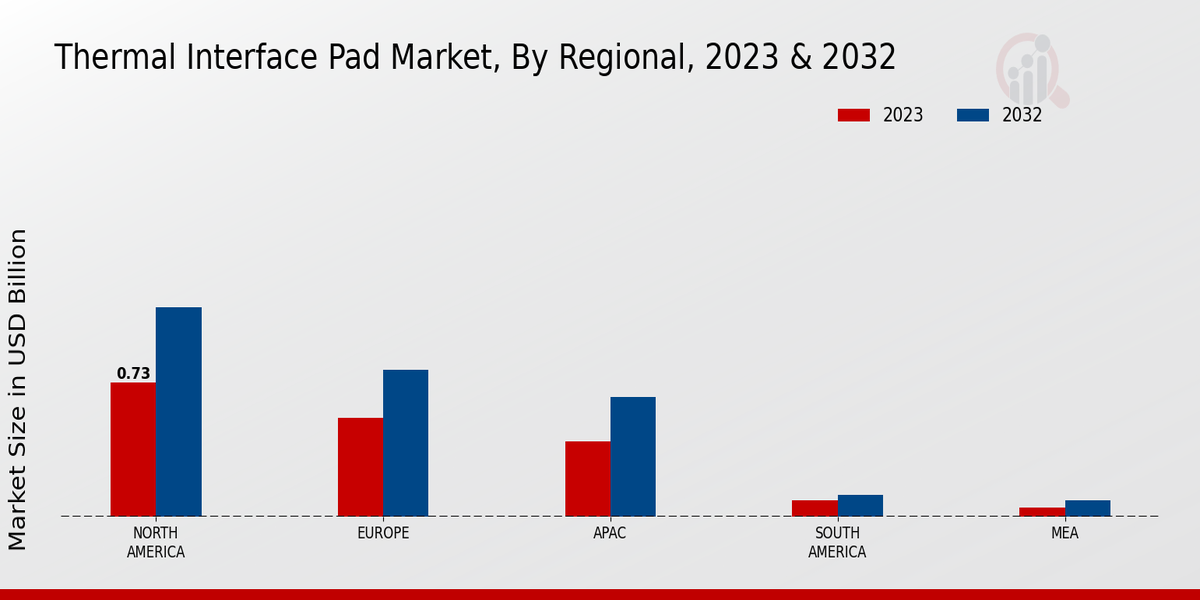Market Growth Projections
The Global Thermal Interface Pad Market Industry is projected to experience substantial growth over the next decade. With an estimated market value of 1.99 USD Billion in 2024, the industry is expected to expand to 3.39 USD Billion by 2035, reflecting a compound annual growth rate (CAGR) of 4.96% from 2025 to 2035. This growth trajectory is indicative of the increasing reliance on thermal management solutions across various sectors, including electronics, automotive, and renewable energy. The anticipated rise in market value underscores the importance of thermal interface pads in addressing the thermal challenges posed by modern technologies.
Growing Demand for Electronics
The increasing demand for consumer electronics is a primary driver of the Global Thermal Interface Pad Market Industry. As electronic devices become more compact and powerful, the need for efficient thermal management solutions intensifies. For instance, the market is projected to reach 1.99 USD Billion in 2024, driven by the proliferation of smartphones, laptops, and gaming consoles. These devices generate significant heat, necessitating the use of thermal interface pads to ensure optimal performance and longevity. The trend towards miniaturization in electronics further emphasizes the importance of effective thermal management, thereby propelling the demand for thermal interface pads.
Advancements in Automotive Technology
The automotive sector is undergoing a transformation with the rise of electric vehicles (EVs) and advanced driver-assistance systems (ADAS). This shift is likely to bolster the Global Thermal Interface Pad Market Industry as these technologies require efficient thermal management solutions. Thermal interface pads play a crucial role in dissipating heat generated by batteries and electronic components in EVs. As the automotive industry increasingly adopts these technologies, the market is expected to grow, contributing to the projected increase to 3.39 USD Billion by 2035. The integration of thermal interface pads in automotive applications indicates a significant opportunity for market expansion.
Emerging Applications in Medical Devices
The expansion of the medical device sector is emerging as a notable driver for the Global Thermal Interface Pad Market Industry. Medical devices, particularly those incorporating advanced electronics, require effective thermal management to ensure reliability and performance. Thermal interface pads are increasingly utilized in devices such as MRI machines, ultrasound equipment, and wearable health monitors. As the healthcare industry continues to innovate and develop more sophisticated technologies, the demand for thermal interface pads is likely to grow. This trend not only highlights the versatility of thermal interface pads but also underscores their critical role in enhancing the functionality of medical devices.
Regulatory Standards and Energy Efficiency
Stringent regulatory standards aimed at improving energy efficiency in various industries are influencing the Global Thermal Interface Pad Market Industry. Governments worldwide are implementing regulations that mandate the use of energy-efficient materials in electronic and automotive applications. This trend encourages manufacturers to adopt thermal interface pads that enhance thermal conductivity and reduce energy consumption. As industries strive to comply with these regulations, the demand for high-performance thermal interface pads is likely to rise. This regulatory push not only supports market growth but also aligns with global sustainability goals, making it a pivotal driver in the industry.
Rising Adoption of Renewable Energy Solutions
The global shift towards renewable energy sources is impacting the Global Thermal Interface Pad Market Industry positively. As solar and wind energy technologies advance, the need for efficient thermal management in power electronics becomes increasingly critical. Thermal interface pads are essential in managing heat in inverters and converters used in renewable energy systems. The growing investments in renewable energy infrastructure are expected to drive the demand for thermal interface pads, contributing to the market's projected growth. This trend reflects a broader commitment to sustainability and energy efficiency, further solidifying the role of thermal interface pads in modern energy solutions.










